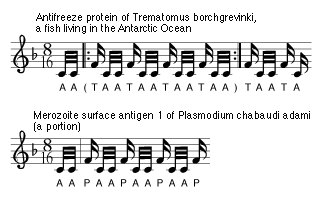 A cold season is coming near and we begin to think of keeping our body
warm. We are able to keep off the coldness by heavily clothed or by heating.
However, other animals cannot behave like us. Especially, fishes living
in icy oceans near the polar regions where the temperature of sea water
becomes under zero degree in winter, are, owing to the fact that they are
poikilotherm, exposed to the risk of freezing. How, on earth, do the fishes
protect their lives under such severe conditions? A cold season is coming near and we begin to think of keeping our body
warm. We are able to keep off the coldness by heavily clothed or by heating.
However, other animals cannot behave like us. Especially, fishes living
in icy oceans near the polar regions where the temperature of sea water
becomes under zero degree in winter, are, owing to the fact that they are
poikilotherm, exposed to the risk of freezing. How, on earth, do the fishes
protect their lives under such severe conditions?
"Necessity is the mother of invention" for fishes whose
lives are in peril
Pure water freezes at zero degree; the freezing point of the blood of
fishes containing salt and other substances is reduced to -0.8 degrees.
This principle is applied to antifreezing fluids in automobiles: if a certain
substance is added to cooling water for engine, the freezing point of the
water is greatly reduced and the water does not freeze even in a very cold
season.
Sea water, on the other hand, containing substances such as salt just as
the blood of fishes, freezes also at a temperature below zero degree. However,
since the concentration of salts in sea water is higher than in the blood
of fishes, the freezing point of sea water becomes -1.9 degrees. The temperature
of sea water with ices is then the same as the freezing point or -1.9 degrees.
Therefore, if the fishes under such conditions have no mechanism for lowering
further the freezing point of their blood by more than 1 degree, their lives
become in peril. Then the fishes, driven by necessity for the protection
of their lives, have developed biological antifreezes called antifreeze
proteins. These proteins are produced in the liver and sent out to circulate
with blood for lowering the freezing point of the blood to -2.2 degrees,
which is low enough to save the fishes from freezing.
A flounder is careful enough as to produce antifreeze proteins just before
the cold season sets in; a cod synthesizes ones in response to the coming
of the cold season. An ocean pout in the Antarctic ocean where the temperature
of sea water is always very low naturally continues to produce antifreeze
proteins all year. It is a wonder that the fishes living under similar conditions
have developed independently proteins having the same function in spite
of the fact that each species acts as its own way to produce antifreeze
proteins and the sequence of amino acids of the antifreeze proteins is different
to each other.
There is profound significance in the similarities between melodies
of proteins
By the way, what characteristics are there in the melody of such antifreeze
proteins? It is the repetition of a melody piece with a fast rhythm, as
can be seen from the score shown as an example. When a cold season comes,
fishes living in a cold ocean play the melody in their body to synthesize
antifreezing proteins and protect themselves from the coldness.
 In fact, the melody has similar effects on us. In other words, to hum
the tune is "the trick for self-heating when it is cold". If you
feel coldness, try to sing the melody in quick tempo while chafing hands
together. You surely feel yourself becoming warm. Although human beings
do not have the antifreeze proteins, the melody acts on proteins with similar
melody pieces and brings us similar effects. In fact, the melody has similar effects on us. In other words, to hum
the tune is "the trick for self-heating when it is cold". If you
feel coldness, try to sing the melody in quick tempo while chafing hands
together. You surely feel yourself becoming warm. Although human beings
do not have the antifreeze proteins, the melody acts on proteins with similar
melody pieces and brings us similar effects.
It is to be noted, however, that the protein music should be treated cautiously.
If you hum the melody when unnecessary, for example when you do not feel
coldness, you may become feverish as a result of ill effects of the melody.
This can be understood by the fact that a protein of a plasmodium contains
the identical melody pieces to that of the antifreeze protein although the
sequence of amino acids is different to each other. If the function of the
melody to make us warm is appropriate in a coldness, the same function makes
us feverish in a hotness.
The similarity of melodies between proteins which are quite different to
each other is called "musical homologies" by Dr. Sternheimer,
who explains the significance as follows: "Based upon the musical homologies,
one may be able to predict the functions of a protein whose functions are
still unknown. For example, since the antifreeze protein and a protein of
a plasmodium have melody pieces in common as explained above, we know that
these two proteins have a common function."
As the example shows us, the fact that different proteins have the same
melody pieces is not a simple coincidence but very significant. We can then
think of many applications of the protein music based on the fact. |
 A cold season is coming near and we begin to think of keeping our body
warm. We are able to keep off the coldness by heavily clothed or by heating.
However, other animals cannot behave like us. Especially, fishes living
in icy oceans near the polar regions where the temperature of sea water
becomes under zero degree in winter, are, owing to the fact that they are
poikilotherm, exposed to the risk of freezing. How, on earth, do the fishes
protect their lives under such severe conditions?
A cold season is coming near and we begin to think of keeping our body
warm. We are able to keep off the coldness by heavily clothed or by heating.
However, other animals cannot behave like us. Especially, fishes living
in icy oceans near the polar regions where the temperature of sea water
becomes under zero degree in winter, are, owing to the fact that they are
poikilotherm, exposed to the risk of freezing. How, on earth, do the fishes
protect their lives under such severe conditions? In fact, the melody has similar effects on us. In other words, to hum
the tune is "the trick for self-heating when it is cold". If you
feel coldness, try to sing the melody in quick tempo while chafing hands
together. You surely feel yourself becoming warm. Although human beings
do not have the antifreeze proteins, the melody acts on proteins with similar
melody pieces and brings us similar effects.
In fact, the melody has similar effects on us. In other words, to hum
the tune is "the trick for self-heating when it is cold". If you
feel coldness, try to sing the melody in quick tempo while chafing hands
together. You surely feel yourself becoming warm. Although human beings
do not have the antifreeze proteins, the melody acts on proteins with similar
melody pieces and brings us similar effects.